Notes phytochemist. Sunset era Habra-banana
- Tutorial
Anfangen ist leicht, Beharren eine Kunst (Start - easy, continue - art)
German proverb
I think the topic of a banana respected habra readers already fed up with order. It’s time, on the one hand, to finally finish with this banana, but write about some garlic. But what to do, the situation is like in that joke about "mice injected, cried, but still ate cactus," because we have not finished with a banana yet. Therefore, in order to finally close the circle and find out about the link between banana and Thai boxing, about the adrenaline from the banana, and about why you need to eat banana instead of lemonand about dolphins from a banana - follow the cat!
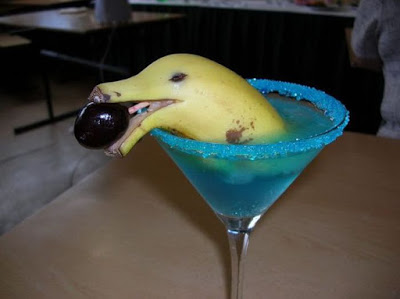
They will be among the lotuses, devoid of thorns, under the bananas with hanging rows of fruits, in the open shadow, among the spilled waters and numerous fruits that do not run out and are accessible.
... says an excerpt from the Koran (56: 27-33) describing the place where devout Muslims will live in the afterlife (literally "ahead of the rest in committing good deeds"). Generally, as far as I am aware, in southeastern Christianity (ie, Christians in Southeast Asia), it is believed that the serpent tempted Eve not with an apple, but with a banana, so that this fruit is quite a serious contender to the pedestal of "Eve's fruit", on a par with with apple, pomegranate and figs. And this has a definite meaning, since some researchers believe that it was the bananas that were the first fruits on the ground. Although it is recognized that the wild banana looks quite unpresentable, has seeds and the taste is not so hot.
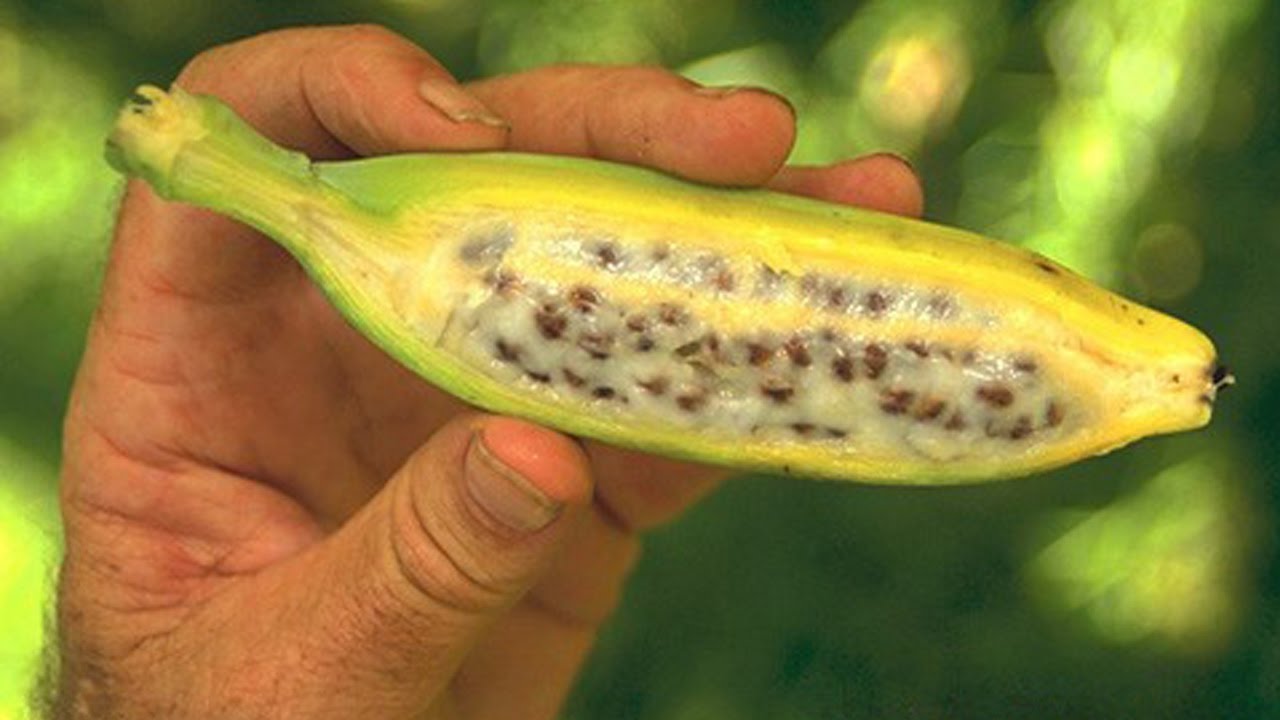
A similar situation, frankly speaking, is observed with many other fruits and vegetables, the wild ancestors of which are at least not particularly tasty. Under the spoiler - a watermelon and a “national” persimmon ( “varieties” of Caucasian wild )
Wild watermelons

Wild persimmon

All modern industrial varieties of bananas presumably evolved from two or three wild banana species: Musa acuminata and Musa balbisiana (well, a little bit of Musa maclayi ) - which gave a hybrid to Musa paradisiaca- fruits that contain many large black seeds of a rounded shape, located along the entire fruit. As a result of the further natural development of bananas, in hybrid species, the seeds have significantly decreased - to the size of a little more than poppy seed. With the development of plant breeding, it became possible to grow sterile bananas, in which seeds are absent altogether (well, or if they are present, then only in the form of faintly visible dark formations - not formed seeds). This fact does not affect the number of banana plantations, since Today, the cultivation of banana plants on plantations occurs predominantly by asexual division. A constantly growing banana tree is either forked off or planted corms. The result is a complete fruit tree,and without any seeds there ).
There is even an assumption that about 95% of the banana bushes, the fruits from which fall on our markets, were originally all derived from the same hybrid plant Musa paradisiaca (the so-called cultigen), which grew somewhere in South Asia.
So, in some ways people are close to bananas. How not to recall the words of genetics Stephen Jones " bananas share 50% of our genes, but that doesn't make them half-human " ( OriSvet means "we have 50% of the common genes with bananas, but this does not make them" half people “), which many media outlets disseminated as a sensation like“ a man descended from a banana. ”In fact, it meant that DNA was far from the only thing that the development of the organism depended on.
So, we continue our historical and ethnographic "introduction to the banana". Researched suggest that the first bananas appeared 10,000 years ago in Southeast Asia. From here, travelers and colonizers sent them to India, Africa and Polynesia. Southeast Asia - a rather lengthy concept = extensible. Moreover, it stretched to as many as 11 countries: this includes both continental Vietnam, Cambodia, Laos, Myanmar, Thailand, Malaysia, and island islands - Brunei, East Timor, Indonesia, the Philippines, and Singapore.
It is not known how my further narrative would have happened, I didn’t read in my time the " Nebula- Native" novel "The Clockwork" or "The Spring Woman" (born The Windup Girl) by the American science fiction writer Paolo Bachigalupi .

The novel is set in the future of Thailand (a future without hydrocarbons, with a lack of food due to the introduction of GMO plants not capable of reproduction). But Thailand, Thailand, this holy keeps its traditions. And what are their main traditions - "Thai boxing" and faith in the omnipresent spirits. And all this, oddly enough, is also associated with a banana.
First - about the banana "tradition of masculinity." Despite the fact that Thailand is in our area a rather popular destination for mattress tourists, your humble servant, looking at photos of friends in social networks tagged with # Phuket # beaches of Thailand or # Bangkok streets , absolutely didn’t see anything interesting there I never thought about going there to rest. And here she is, the motivating force of reading, after reading Windup Girl, I really wanted to visit the legendary Lumphini Stadium, which hosts Muay Thai fights. For two days I read with delight about the history of the kingdom of Ayutthy and the legendary fighter Nai Kham Tom ( Nai Khanom Thom), in honor of which so-called is held annually on March 17 in modern Thailand. “Boxing Night” - National Muay Thai Holiday. Under the spoiler - a gray-haired legend about Nai Kham Tom

В 1774 году, во время войны с Бирмой в плен к бирманцам попали несколько гвардейцев, которые, как правило, были признанными мастерами Муай Тай. Король Бирмы лорд Мангра пожелал выяснить, какое из боевых искусств сильнее: тайский бокс или парма — древнее бирманское боевое единоборство — и в 1775 году, Мангра по совету одного из приближённых, велел устроить в Рангуне поединок между бойцами разных школ. Среди пленённых тайцев был Най Кхам Том (Nai Khanom Thom) — известный в то время тайский мастер. Ему и предстояло провести первый поединок. До начала поединка, Най Кханом Том исполнил странный (для бирманцев) танец вокруг своего противника (танец «Рам Муай» — часть философии Муай Тай, предназначенный для подготовки к бою и выражения уважения к своим предкам, учителю и противнику). Сама схватка была мгновенной, но судья не засчитал её, ибо решил, что таец намеренно ввёл в заблуждение противника своими нелепыми движениями. Бирманцы выставили другого бойца и все повторилось снова. Десять (или, по другим сведениям, даже 11) воинов парму поочерёдно выходили на бой и все они были повержены мастером Муай Тай, который даже не имел возможности отдохнуть между схватками. Мангра был так поражён произошедшим, что немедленно даровал пленнику свободу и предложил на выбор награду — либо деньги, либо любовь молодых рабынь. Най Кхам Том выбрал второе, справедливо рассудив, что достойное жалование он сможет получить в любое время. Вскоре мастер тайского бокса вернулся домой, а впереди героя летела слава. На родине Най Кхам Том стал настоящим символом несокрушимости Муай Тай, а значит и несокрушимости тайского духа и непобедимости Таиланда.
How does a banana relate to such a wonderful person, you ask? And so ... A banana is a very unpretentious plant, in Asian countries it grows on its own, like a weed. In each Thai house there are several of these annual plants that bloom and bear fruits year-by-year. In many martial arts, the practice of practicing strikes using wooden pillars or trees as a punching bag is well known. In Thailand, for this purpose since ancient times used a banana shrub. Training related to striking a soft and supple banana “wood” was used by Thai fighters for centuries (from 2-3 centuries AD), the banana was especially well suited for practicing kicks. Such a practice existed until the appearance of various patches and dummies with a “stuffed” structure. And now in Thailand you can meet potential fighters who train strikes on a banana bush (most often, due to the lack of the possibility of acquiring modern sports equipment). In memory of those ancient times, today the so-called. “Thai punching bag” is unofficially called a “banana” because reminds in its characteristics not so much a fruit as a tree. The length in human height and weight, reaching up to 100 kg make it an ideal projectile for practicing kicks, the impact energy is evenly distributed throughout the bag and shaking such a projectile is very difficult. reminds in its characteristics not so much a fruit as a tree. The length in human height and weight, reaching up to 100 kg make it an ideal projectile for practicing kicks, the impact energy is evenly distributed throughout the bag and shaking such a projectile is very difficult. reminds in its characteristics not so much a fruit as a tree. The length in human height and weight, reaching up to 100 kg make it an ideal projectile for practicing kicks, the impact energy is evenly distributed throughout the bag and shaking such a projectile is very difficult.
A little bit of oil. Thai boxing is not only an excellent social elevator for any resident of Thailand, regardless of his status, but also an independent complex and beautiful tradition. Therefore, to be honest, the promo videos of some fighters with grimacing, incomprehensible music, etc. sometimes hurt the eyes and repel. Once again, I praise our Belarusian fighters, in particular, my beloved Denis Goncharenka (
No yang without yin. We turn to the banana "tradition of femininity." That in Thailand is also available. And it is connected neither more nor less, but with Mrs. Tanya . As I already mentioned, Thais are very respectful of otherworldly creatures, ghosts, which they sincerely believe, constantly surround all living. One of the most common and revered fictional creatures are banana fairies, or Nang Thani (tai. นาง ตานี). Periodically, I saw friends have amulets brought from Thailand, such as these:
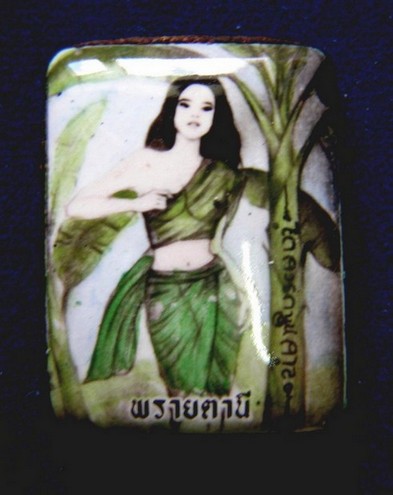
This is the banana fairy. By the way, Thai Wikipedia describes these spirits "the spirit appears among the thickets of wild banana and looks like a young girl dressed in traditional Thai clothes, with a beautiful face, long hair smelling like banana, red feet like a pigeon and lips the color of ripe pumpkin. .. ". Wild banana is the very Musa balbisiana, if anything. In Thailand, it is also called “Kluai Tani” (Thai. กล้วย ตานี) and try not to plant near houses. Therefore, thickets “Kluai tani” (“Tanya's tree”) are often found on the outskirts of villages or along the edges of cultivated fields, on roadsides. And why be afraid, you ask, like, well, "a girl with a beautiful face." And not everything is so simple, it is believed that this ghost harms, and especially those who enter into various discrediting ties. So,%% username, relaxing in Thailand, forget about Tanya, if you're not a bachelor.
In addition, as is the case with our "local" mermaids, it is believed that Tanya can take a physical image and act as a kind of wife, pulling all the energy out of an unhappy man ("yang"). Because “Tani is a female ghost who is ruled by Yin power, any man is a carrier of Yang power. Since the ghost, unlike a living person, has a very weak energy, in order to achieve balance, it will take away the power from a man, even to the death. ” To determine a man who is in the power of Tanya can be a sharp cyclical reddening / blanching cheeks. If this happens, experts advise to invite a wandering monk to share the essence. This is such an uneasy banana "thing" that Tanya.

Legends and traditions, of course, is an interesting and attractive thing. But it is impossible to verify them, and therefore it can be used in a limited way, for “jokes for the sake” But biochemistry is a serious thing that has its practical application. And in this case, most often people who read my epic about a banana, were interested in the content of dopamine and serotonin in this fruit - “accessible sources of happiness and pleasure”.
Banana adrenaline
How many miraculous substances are not attributed to bananas all kinds of one-day sites and supervising their copywriting masters. And the hormone of happiness, and the hormone of love, and dopamine, and serotonin, and "eat and be happy" and "analogue of the cactus peyote." In my opinion, in no other fruit are so “mixed in a bunch of horses, people ...
But seriously, the banana belongs to a small group of plants that contain biologically active components characteristic of the animal world and man in particular. Another thing is whether they can be used as intended. Typically, this is the main snag. Banana is no exception. It really contains such important for human physiology substances as serotonin, dopamine, norepinephrine and adrenaline (ephedrine and mescaline is not, do not even look, but they are well replaced by bananadine ). Before I tell you how they turned out to be in a banana in general, let me briefly recall their physiological role.
Lyrical digression. There is an excellent phrase "beauty is functional." And now, refreshing my knowledge of biology, I look at photos of the brain and marvel at how beautiful its internal structure is. In the video simulation , the work of the brain (in continuation of my concept of “the universe within us”, which began with microbiota ...), which would have been impossible without the participation of the neurotransmitters described below.
And now about chemical "gears", thanks to which this beauty is possible. First we will have serotonin. In the human body, it acts as a neurotransmitter, i.e. chemical component responsible for the transmission of impulses between brain cells. It is good that in the anterior part of the brain, areas responsible for the process of cognitive activity are stimulated under the influence of serotonin. Serotonin entering the spinal cord has a positive effect on motor activity and muscle tone. This condition can be characterized by the phrase "I turn mountains." Finally, the most important thing is that an increase in serotonergic activity creates a feeling of elevated mood in the cerebral cortex. Lack of serotonin, on the contrary - causes a decrease in mood and depression. In addition to mood, serotonin is responsiblefor composure or emotional stability. Serotonin controls the susceptibility of brain receptors to stress hormones adrenaline and norepinephrine (which will be discussed later). In people with low serotonin levels, the slightest cause causes an abundant stress response. Some researchers believe that the dominance of individuals in the social hierarchy is due precisely to the high level of serotonin.
Next in line are the three "brothers" -catecholamine - dopamine (aka dopamine), adrenaline and norepinephrine. These substances belong to the same class of biogenic amines involved in the transmission of impulses in the nervous system. The compounds may carry a hormonal load, i.e. regulate metabolism (for example, changes in the concentration of glycogen by the combination of adrenaline / norepinephrine), as well as transmit impulses in the peripheral nervous system ( vegetative ) and control all internal organs.
Dopamine is also interesting in addition to the “pleasure hormone / pleasure hormone” that has scorched the teeth, which is actively involved in the human decision-making process. At least among people with impaired dopamine synthesis / transport, many have difficulty making decisions. This is due to the fact that dopamine is responsible for the "feeling of reward", which often allows you to make a decision, considering this or that action on a subconscious level.
Adrenaline is the most important hormone (no longer a neurotransmitter, like the above-mentioned compounds), which implements “hit or run” reactions. Its secretion increases dramatically in stressful conditions, borderline situations, the sense of danger, anxiety, fear, injuries, burns and shock. As it enters the body, it strengthens and speeds up the heartbeat; causes narrowing of muscle vessels, abdominal cavity, mucous membranes; relaxes the muscles of the intestines, and dilates the pupils. So "fear has big

Norepinephrine is a hormone and neurotransmitter. Norepinephrine also increases with stress, shock, trauma, anxiety, fear, and nervous tension. Unlike adrenaline, the main effect of norepinephrine is exclusively in the narrowing of blood vessels and high blood pressure. The vasoconstrictor effect of norepinephrine is higher, although the duration of its action is shorter. Immediately after determining the situation as stressful, the hypothalamus secretes corticotropin (adrenocorticotropic hormone) into the blood, which, upon reaching the adrenal glands, induces the synthesis of norepinephrine and adrenaline. Interestingly, in different animals the ratio of cells that synthesize adrenaline and norepinephrine fluctuates. Noradrenocytes are very numerous in the adrenal glands of predators and almost never occur in their potential victims. For example, in rabbits and guinea pigs they are almost completely absent. You can often hear the phrase “adrenaline - the hormone of fear, and norepinephrine - the hormone of rage,” and this makes sense, since it is noradrenaline that causes a person to feel anger, rage, permissiveness. So, given the above about the hypothalamus, you can quite confidently say that the emotions of fear and hatred are related, and are generated by one of the other.
I think about the impression of what these substances are and what they are for, it is quite possible from my brief review. Now about where they come from in the body. Basically, everything is synthesized endogenously either inside the brain (like dopamine), or using a microbiota (like serotonin). Those. when ingested, potential neurotransmitters and hormones must first go through a long digestive path and remain unchanged. And secondly, even if they succeeded in some incredible way, there is still such a thing as the blood-brain barrier - the main "citadel" of our brain.


The blood-brain barrier (BBB) is a highly selective semi-permeable border that separates the circulating blood from the brain and extracellular fluid in the central nervous system (CNS). This system allows water, some gases and fat-soluble molecules to pass through passive diffusion, and also provides selective transport of molecules (glucose and amino acids), which are important for the nervous function. The BBB, on the one hand, limits the penetration of "foreign bodies" from the blood into the brain (bacteria) and large or hydrophilic molecules into the cerebrospinal fluid, and on the other, it is the transport channel through which the hydrophobic molecules (O 2 , CO 2, hormones) and small polar molecules. In addition, the BBB cells actively transport various metabolic products from the brain using specific transport proteins.In short, no hormone or neurotransmitter can normally penetrate this barrier and it will be useless to rush along the bloodstream until it is metabolized. Although the same adrenaline and norepinephrine, in general, do not aspire to the brain, exerting a local effect on the vessels and tissues of the body. But, but these hormones are quickly destroyed in the digestive tract.
So there is only one way - to feed precursors (precursors) into the body, i.e. substances from which the potential can produce the required components. In the case of a living organism, it is most often amino acids. For example, in order for serotonin to be produced in our body, two things are needed:
- dietary intake of the amino acid tryptophan - since it is necessary for the direct synthesis of serotonin in synapses
- glucose intake with carbohydrate foods => stimulation of insulin release into the blood => stimulation of protein catabolism in tissues => increase in the level of tryptophan in the blood.

But there is such a nuance. Consumption of purified tryptophan actually increases the serotonin content in the brain, while eating food containing tryptophan does not contribute to this. This is due to the fact that the transport system, which conducts tryptophan through the BBB, has selectivity for other amino acids contained in protein sources). High plasma levels of other neutral amino acids compete within the transport system, and they can also prevent the process of increasing serotonin synthesis against elevated plasma levels of tryptophan.
As for dopamine, both its amino acid tyrosine and levodopa L-DOPA (see the biosynthesis scheme in plants below) and tyramine (formed as melanin, with the participation of polyphenol oxidase (PPO)) can serve as its precursor - see the article on banana sandpaper).
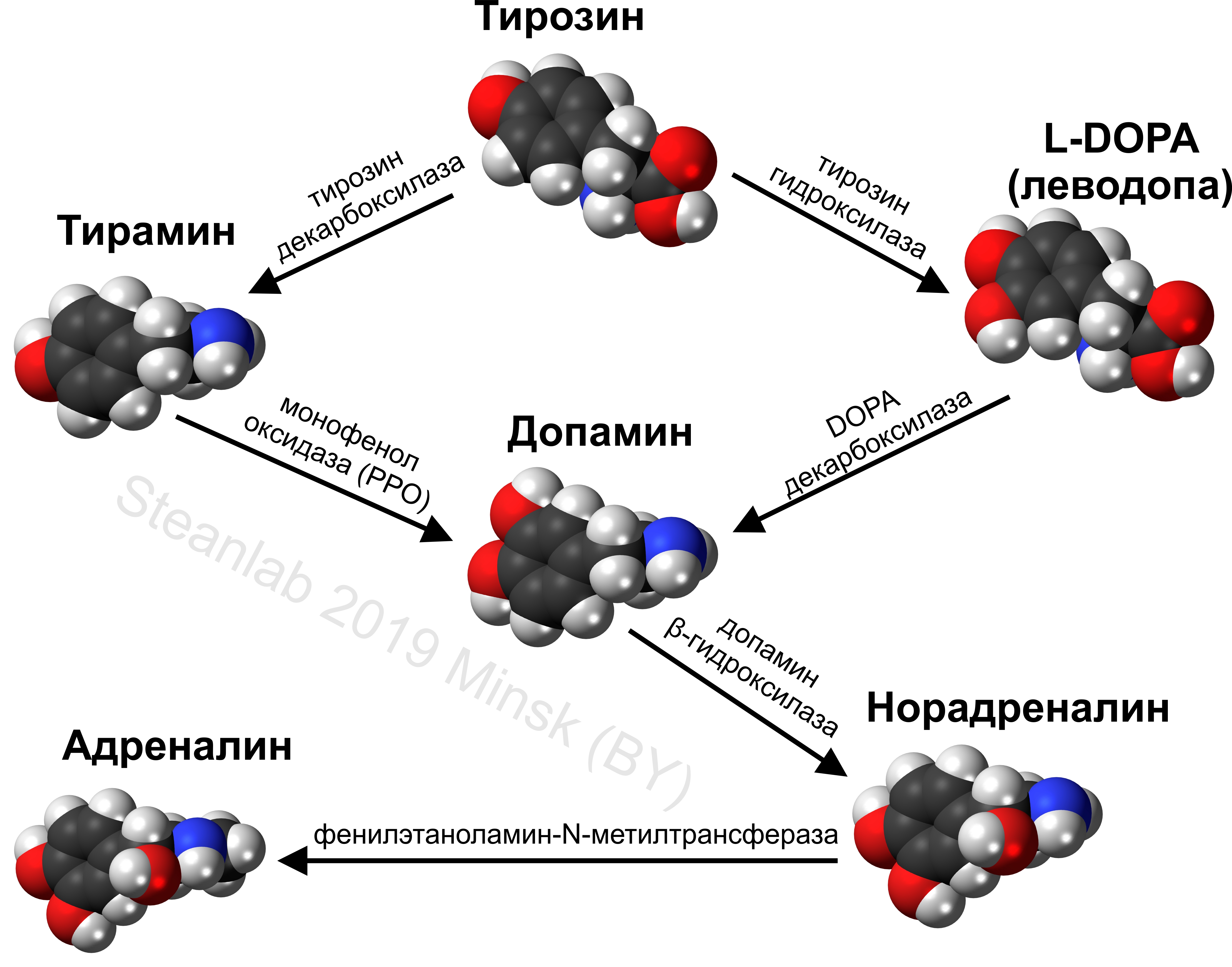
So there is a banana in search of good mood and pleasure, to put it mildly, is not the most productive option (the same mentioned amino acids are contained in much larger quantities in oranges or persimmon, and you need to try to get to the maximum L-DOPA due to ripening = roulette ). But if you consider a banana as a natural source of antioxidants, then here the probability of obtaining a positive effect is much higher. Dopamine, and melanin, by the way, are excellent antioxidants. In particular, it is believed that dopamine is comparable in its activity with epigallocatechin gallate(contained in green tea and persimmon). Summing up, you can confidently say - “eating a banana is necessary.” Something can be extracted with water, preparing water tinctures of banana peel (the so-called kvass of Boris Bolotov ’s grandfather ). The benefits from them are exactly the same as from water extracts / compotes from others fruit. Well, adrenaline, by the way, due to its activity, can (and should) be applied as an external remedy (I already wrote about this with an edge in an article about banana skin, explaining why it works perfectly as a local anti-inflammatory and anti-allergic agent for a bite x insects, etc.).
Fat of the ... banana
A small lyrical digression. I don’t know how many readers are aware of, but the Unicode standard includes the emoji U + 1F34C BANANA symbol (HTML & # 127820). I honestly tried to insert a "banana stick figure" into the headers, but the habr parser kept my HTML clean. If anything, under the spoiler other vegetables and fruits that are included in Unicode. Not many have received such honor ...

Okay, go to the serious questions. This time (as follows from the title) I decided to devote a separate section to the fats and fat-soluble compounds present in the banana, so that the conversation is nothing less than “banana fat” and its benefits.
In modern nutrition, there is such a thing as functional foods. This concept is treated differently, someone with approval, someone, on the contrary, with a negative.
Functional food is food that is given additional functions (often associated with health promotion or disease prevention) by adding new ingredients or a few existing ingredients. This term can also be applied to edible plants with an increased content of anthocyanins, carotenoids and other natural biologically active components.This term was first used in Japan, in the distant 1980s, when the government approved a plan for the development and introduction to nutrition of special functional (read "preventive") foods. The whole thing was called FOSHUor "Products for Special Medical Use." In fact, as I reasonably noticed in the comments to one of the articles, such “functional” (i.e., enriched with microelements, for example) products were actively used in our area, take at least the same iodized or fluorinated salt. Theoretically, commentators are right, since everything was initially developed in order to "... reduce the risk of chronic diseases, be like ordinary food and be consumed as part of an ordinary diet." But in practice, in order to be considered functional, food must contain not only an increased number of trace elements, but also at least a few, which are not originally characteristic (or contained in very small quantities) for it, biologically active substances.
A typical example of such biologically active substances, which for decades have acted as functional additives to food, can be plant sterols (close relatives of cholesterol, see below).
Phytosterols (phytosterols; plant sterols / sterols) are compounds that belong to the group of steroid alcohols naturally present in plants. These compounds are cholesterol-like substances, differing only in the number of carbon side chains and / or the presence or absence of a double bond.
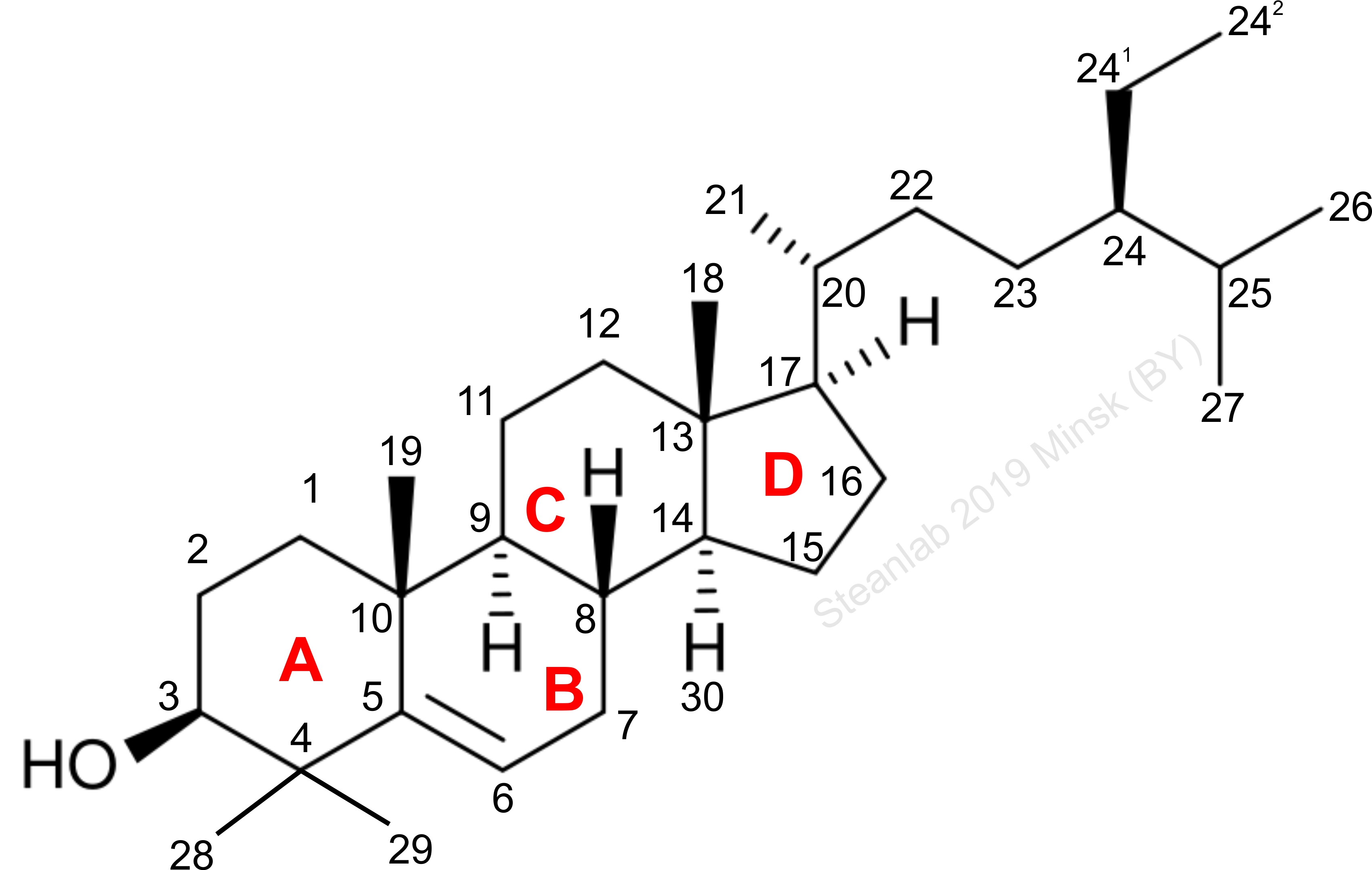
Practically all phytosterols existing in nature can be adjusted to the given formula. For example, by removing carbon 24 1 and 24 2 , we get cholesterol. Removing carbon 24 2 - we get the compound campesterol. Removing hydrogen from carbon atoms 22 and 23 gives stigmasterol. By hydrogenating a double bond between 5 and 6 carbon atoms, β-sitostanol (stigmastanol) is obtained, and if hydrogenation of atoms is added to the removal of the carbon atom 24 2, we get campestanol. Etc. etc.
Increased attention to this compound is due to the fact that they firstly reduce the level of cholesterol in the blood, and secondly, they seriously reduceabsorbability of cholesterol intestines, thereby reducing the risk of atherosclerosis. In addition, articles sometimes appear in which phytosterols act as immunomodulators and even antitumor agents.
And now the most important thing is that there are quite a few of these compounds in a banana. It can even be said that among the available on the shelves of our markets / fruit stores, bananas are the leaders in phytosterol content. According to various data, sterols make up from 12 to 43% of the total amount of lipophilic (fat soluble) compounds in a banana. The most common are β-sitosterol, campesterol and stigmasterol. By the way, the table below shows the composition of the fat-soluble extract from a banana (there are sterols and tokoferols and saturated / unsaturated fatty acids).
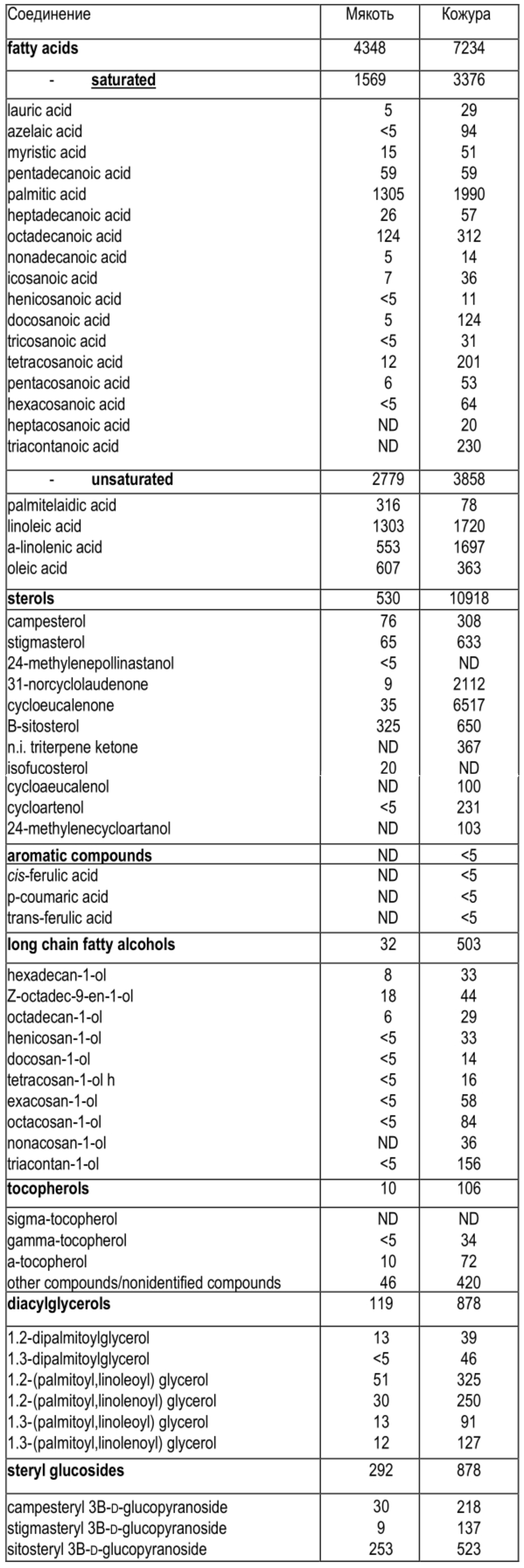
Note : The picture below shows the approximate composition of the main components found in a dichloromethane extract of a banana skin and fruit, before (BH) and after (AH) alkaline hydrolysis of FA-fatty acids; LCAA - long chain aliphatic alcohols, ST-sterols, AC - aromatic compounds.

As you can see, a lot of useful thing still remains in the skin and is thrown away. Those. theoretically, quite a real option - to make a fat extract of a banana skin and use it as an additive to food containing cholesterol. Hindus know this because they prepare some varieties of their chutney sauces , served to fatty dishes, from banana peel. Fans of cooking at home give a hint - recipes for sauces are searched on Google in English using the keywords сhutney banana peel . And there really look what looks nicer .
Since the conversation has gone about the dishes, it's time to turn to questions of the feasibility of eating a banana together with alcoholic beverages.
Алкогольные напитки ухудшают всасываемость питательных веществ из пищи, нарушают многие звенья объёма веществ в организме: белков, углеводов, жиров, минеральных солей. В результате в органах и тканях накапливаются кислые продукты, нарушается кислотно-щелочное равновесие, и это приводит к серьёзным нарушениям обмена веществ
Всего через несколько минут после поступления алкоголя в организм магний выводится через почки и попадает в мочевой пузырь. Магний перестаёт блокировать кальциевые каналы в клетках и кальций беспрепятственно проникает внутрь клеток, вызывая их чрезмерное возбуждение.
The reasoning “is it possible to eat a banana” is more than a dozen years. This has become even a kind of joke. Even the notorious “uchonnyy” comrade Shnurov in his equally well-known composition gave a whole couplet to this issue
Songs from Magadan,It is logical that since a much larger number of people listen to the Leningrad group, rather than read Habr, they will never eat a banana, risking to be the object of ridicule from “advanced” friends. And make a very serious mistake. After all, it's all about phospholipids.
TV on the couch,
Vodka to eat a banana
Loves our people.
Phospholipids are a class of lipids (fats), which are the main component of all cell membranes. The structure of the phospholipid molecule usually consists of two hydrophobic "tails" of fatty acids and a hydrophilic "head" consisting of a phosphate group. The two components are joined together by a glycerol molecule.

Phospholipids always accompany fats in food and serve as a source of phosphoric acid necessary for human life. They are actively involved in the transport of fats, fatty acids and cholesterol. Being more hydrophilic than cholesterol, due to the presence of phosphoric acid residues in the molecule, phospholipids are a kind of “solvent” for cholesterol and other highly hydrophobic compounds. In general, the compounds are quite useful and, most importantly, present in a banana. The picture below shows the main ones.
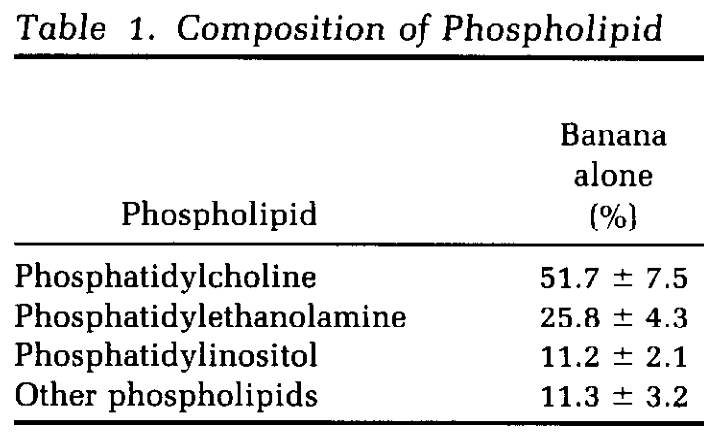
In principle, the properties of a banana to soothe bouts of heartburn have been known for a long time and even traditional medicine in many countries recommends using this fruit as an antacid.
Antacids (from other Greek ἀντι- "against" + Latin acidus "sour") are drugs intended for the treatment of acid-related diseases of the gastrointestinal tract by neutralizing hydrochloric acid, which is part of the gastric juice.At the end of the last century, it was also established that substances contained in bananas (“banana phospholipids”) can, in addition to the antacid, also have a significant anti-ulcer effect . Well, the “cherry on the cake” can be considered an article in which researchers clearly demonstrated how an immature banana phosphatidylcholine can prevent acute lesions of the gastric mucosa in rats caused by the use of ethyl alcohol. In addition, the same article shows the protective effect of banana phospholipids in chronic ulcers. The picture shows the physical model of the protective mucous membrane of the stomach, formed by a monolayer of adsorbed surface-active phospholipids (+ coating of intercalated proteins).

So think next time, "lemon or still a banana ...".
findings: here is the end of the phytochemical (and sided) examination of a banana. I hope that no one now has any doubts that the banana is not only a valuable food crop, but also a medicine (and even a ready-made “functional product”). Despite the fact that there are indeed serotonin, dopamine and melanin in the banana, they cannot get directly into the brain through the stomach for good reason. But small amounts of amino acids from which, in the process of maturation, the neurotransmitters mentioned above are formed and hormones may well serve as precursors (precursors) from which the brain synthesizes the necessary components. The hormone adrenaline, mostly contained in the skin, is quite a can be used externally for allergic reactions (similar to subcutaneous injection). Well, the most valuable thing in a banana is “banana fat”, i.e.
The most important stages of the "banana era":
- Notes phytochemist. Radio banana
- Notes phytochemist. Banana skin strikes back
- Notes phytochemist. Green banana, or Do not forget to feed the microbiota
Sergey Besarab ( Siarhei V. Besarab )
Ah, and I almost forgot. Banana dolphin :) Every year, April 10th is Banana Day. According to unconfirmed information, it was on this day that in the middle of the 19th century in London they first began selling this fruit. So,% USERNAME%, today add a reminder to To Do, and after 2 months and 21 days make a festive table using the instructions below ( click on the presentation is clickable ) and mark this event well.

PS: To add some interactivity when writing the following "phyto-review", I ask dear readers to spend a minute and vote for your favorite challenger (we traditionally vote on habr rules - 3 days).
- https://www.sciencedirect.com/science/article/pii/S0168945206003025
- https://www.jstage.jst.go.jp/article/jphs1951/18/2/18_2_162/_article
- https://www.sciencedirect.com/science/article/abs/pii/0031942277830045
- https://link.springer.com/article/10.1007/BF00203119
- http://ethology.ru/library/?id=287
- https://www.crcpress.com/Neurotransmitters-in-Plants-Perspectives-and-Applications/Ramakrishna-Roshchina/p/book/9781138560772
- https://en.wikipedia.org/wiki/Potassium-40
- https://en.wikipedia.org/wiki/Blood–brain_barrier
- https://en.wikipedia.org/wiki/Phytosterol
- Oliveira, L., Freire, C. S. R., Silvestre, A. J. D., & Cordeiro, N. (2008). Lipophilic Extracts from Banana Fruit Residues: A Source of Valuable Phytosterols. Journal of Agricultural and Food Chemistry, 56(20), 9520–9524
- https://www.ncbi.nlm.nih.gov/pmc/articles/PMC2077351/
- https://www.ncbi.nlm.nih.gov/pubmed/19630576
- Kanazawa, K. and Sakakibara, H. (2000) High content of dopamine, a strong antioxidant, in Cavendish banana. Journal of Agricultural and Food Chemistry 48,844-848.
- Coutts, R.T., Baker, G.B. and Pasutto, F.M. (1986) Foodstuffs as sources of psychoactive amines and their precursors: content, significance and identification. Advances in Drug Research 15, 69-232.
- Marriott, J. and Palmer, J.K. (1980) Bananas — Physiology and Biochemistry of Storage and Ripening for Optimum Quality. CRC Critical Reviews in Food Science and Nutrition 13(1). CRC Press, Boca Raton, Florida, pp. 41-88.
- Goel, R.K., Tavares, I.A. and Bennett, A. (1989) Stimulation of gastric and colonic mucosal eicosonoid synthesis. Journal of Pharmacy and Pharmacology 41,747-750.
- Dunjic, B.S., Svensson, I., Axelson, J., Adlercreutz, P., Ar 'rajab, A., Larsson, K. and Bengmark, S. (1993) Green banana protection of gastric mucosa against aspirin induced injuries in rats. A multicomponent Mechanism? Scandinavian Journal of Gastroenterology 28, 894-898.
- Best R, Lewis DA, Nasser N. The anti-ulcerogenic activity of the unripe plantain banana (Musa species). Br J Pharmacol 1984;82: 107- 16
- Hills BA, Kirwood CA. Surfactant approach to the gastric mucosal barrier: protection of rats by banana even when acidified. Gastroenterology 1989;97:294-303.
- Wade NL, Bishop DG. Changes in the lipid composition of ripening banana fruits and evidence for an associated increase in cell membrane permeability. Biochim Biophys Acta 1978; 529: 454-64.
Only registered users can participate in the survey. Sign in , please.
What plant would you be interested in reading the note?
- 20% Apple 64
- 14.7% Pomegranate 47
- 3.4% Melon 11
- 3.4% Strawberry 11
- 6.2% Watermelon 20
- 11.9% Kiwi 38
- 5% Grapes 16
- 8.1% Black currant 26
- 26.9% Potato 86
